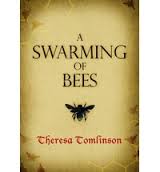A Swarming of Bees
England, Whitby, mid seventh century and at the height of crisis for the early Christian church when the celebration of the Easter festival was dividing Celtic English and Roman Catholic Belief. A great Synod was held at Whitby Abbey, Yorkshire, where the important dignitaries gathered to debate and decide upon an agreed formula for the Easter dates. Against this opening setting, A Swarming of Bees leads the reader gently into a “why-dun-it” murder mystery, as the author Theresa Tomlinson describes it.
Fridgyth is the pagan herb-wife employed by Abbess Hild of Whitby to see to the monastery’s medicinal needs. Apart from it making an agreeable change to have a female apothecary and healer, I enjoyed the concept of her also being the ‘head sleuth’ Cadfael style. Through Fridgyth’s eyes, the story revolves around a charming cast of characters, some real, some imagined. When plague hits the community – indeed the country – the natural deaths are added to by a poisoner who is making best use of the devastation. Fridgyth is set the task, by the Abbess, of discovering who the poisoner is, for as a simple herb-wife, she can go anywhere, anytime, almost unnoticed.
The plot is a little ambling in places where it reads more like a country stroll rather than a hurry and turn the pages action-packed adventure, but the fascination of the detail, historical and medical, and the realism of the variety of individual characters makes this a story to sit and relax with, and is a delight to read.
Some readers may find it difficult to remember the characters because of the unfamiliar Anglo-Saxon names; this is always a hurdle for authors who write about periods or places where names are very different from our English comfort zone, but the story is intriguing and entertaining enough to carry anyone through any potential minor confusion.
Well researched, well written, and well read! Recommended.










